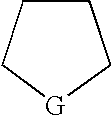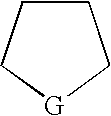Source reagent compositions and method for forming metal films on a substrate by chemical vapor deposition
- Summary
- Abstract
- Description
- Claims
- Application Information
AI Technical Summary
Benefits of technology
Problems solved by technology
Method used
Image
Examples
example 1
Synthesis of Ta(OEt)4(η2-thd)
[0180]One equivalent (33.9 g) of 2,2,6,6-tetramethyl-3,5-heptanedione (Hthd) was added directly to 74.6 g Ta(OEt)5 in a 500 mL Schlenk flask; both starting materials were obtained commercially (Lancaster Chemicals, Inc.). The vessel was heated to 65° C. under a slow nitrogen purge to a bubbler. After 2 hours, the ethanol generated was removed in vacuo to yield 99.8 g of the colorless liquid Ta(OEt)4(η2-thd) in quantitative yield, which solidified upon cooling. The compound melted at 26° C. and boiled at approximately 80° C. at 140 mtorr. The 1H and 13C NMR spectra in benzene-d6 were consistent with an octahedral structure composed of two ethoxide ligands in axial positions and a second set of cis-ethoxide ligands in the equatorial plane across from the bidentate β-diketonate: d 5.81 (s, 1H, CH), 4.72 (q, 4H, CH2), 4.20 (q, 4H, CH2), 1.34 (tr, 6H, CH3), 1.14 (tr, 6H, CH3), 1.13 (s, 18H, t-Bu); 13C{1H} NMR(C6D6) δ 199.9 (CO), 92.9 (CHdiket), 68.8 (CCH2CH3)...
example 2
Synthesis of Ta(OiPr)4(η2-thd)
[0181]A nine-fold excess of isopropanol (170 mL) was added to 33.6 g Ta(OEt)4(η2-thd). The solution was heated at 60° C. for 45 min, following which the volatiles were removed in vacuo. The ligand exchange procedure was repeated a second time to yield 36.8 g of white, crystalline Ta(O-i-Pr)4(η2-thd) in quantitative yield. The product was purified by sublimation at 100° C. at 150 mtorr. The compound melted at 149° C. The 1H and 13C NMR spectra in benzene-d6 were consistent with an octahedral structure composed of two isopropoxide ligands in axial positions and a second set of cis-isopropoxide ligands in the equatorial plane across from the bidentate b-diketonate: d 5.81 (s, 1H, CH), 5.10 (sept, 2H, CH), 4.51 (sept, 2H, CH), 1.38 (d, 12H, Me), 1.20 (d, 12H, Me), 1.17 (s, 18H, t-Bu); 13C{1H} NMR(C6D6) δ 199.4 (CO), 93.0 (CHdiket), 75.0 (CHMe2), 71.4 (CHMe2), 40.8 (CMe3), 28.3 (CMe3), 26.4 (CHMe2), 25.8 (CHMe2).
example 3
Synthesis of Nb(OEt)4(η2-thd)
[0182]The procedure of Example 1 is followed, using Nb(OEt)5 as starting material rather than the tantalum ethoxide. One equivalent of 2,2,6,6-tetramethyl-3,5-heptanedione (Hthd) is added directly to Nb(OEt)5 in a Schlenk flask. The vessel is heated to about 65° C. under a slow nitrogen purge to a bubbler. After 2 hours the ethanol generated is removed in vacuo to yield Nb(OEt)4(η2-thd) in quantitative yield.
PUM
| Property | Measurement | Unit |
|---|---|---|
| Temperature | aaaaa | aaaaa |
| Temperature | aaaaa | aaaaa |
| Temperature | aaaaa | aaaaa |
Abstract
Description
Claims
Application Information
 Login to View More
Login to View More - R&D
- Intellectual Property
- Life Sciences
- Materials
- Tech Scout
- Unparalleled Data Quality
- Higher Quality Content
- 60% Fewer Hallucinations
Browse by: Latest US Patents, China's latest patents, Technical Efficacy Thesaurus, Application Domain, Technology Topic, Popular Technical Reports.
© 2025 PatSnap. All rights reserved.Legal|Privacy policy|Modern Slavery Act Transparency Statement|Sitemap|About US| Contact US: help@patsnap.com


